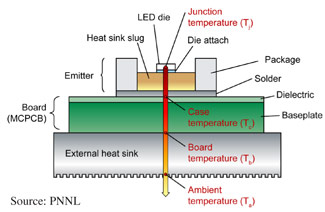Polytronics
Technology Corporation (PTTC)
in conjunction with DENKA
has now developed a brand new material
technology focused on thermal management. It covers the
following product
lines.
- Thermal
conductive compounds
- Thermal
conductive substrates including IMS and FS
- Thermal
conductive modules
These
technological materials have practical applications in a
large variety
of appliances and products ranging from home to commercial
and industrial
settings.
Thermal
Management
LEDs
wonˇ¦t burn your hand compared to the more common light sources,
but they do produce heat. In fact, thermal management is
arguably the most important aspect of successful LED system
design. PTTC has mastered this working
design in a LED system package, either in a module or substrate
form.
Why
Does Thermal Management Matter?
Excess
heat directly affects both short-term and long-term LED
performance. The short-term (reversible) effects are color
shift and reduced light output while the long-term effect
is accelerated lumen depreciation and thus shortened useful
life.
The
light output of different colored LEDs responds differently
to temperature changes, with amber and red the most sensitive,
and blue the least. (See graph below.) These unique temperature
response rates can result in noticeable color shifts in
RGB-based white light systems if operating Tj differs from
the design parameters. LED manufacturers test and sort (or
ˇ§binˇ¨) their products for luminous flux and color based
on a 15-20 millisecond power pulse, at a fixed Tj of 25˘XC
(77˘XF). Under constant current operation at room temperatures
and with engineered heat mitigation mechanisms, Tj is typically
60˘XC or greater. Therefore white LEDs will provide at least
10% less light than the manufacturerˇ¦s rating, and the reduction
in light output for products with inadequate thermal design
can be significantly higher.
Continuous
operation at elevated temperature dramatically accelerates
lumen depreciation resulting in shortened useful life. The
chart below shows the light output over time (experimental
data to 10,000 hours and extrapolation beyond) for two identical
LEDs driven at the same current but with an 11˘XC difference
in Tj. Estimated useful life (defined as 70% of initial lumen
output) decreased from ~37,000 hours to ~16,000 hours, a 57%
reduction, with the 11˘XC temperature increase.
However,
the industry continues to improve the durability of LEDs
at higher operating temperatures. The Luxeon K2, for example,
claims 70% lumen maintenance for 50,000 hours at drive currents
up to 1000 mA and Tj at or below 120˘XC. (Luxeon K2 Emitter
Datasheet DS51, dated 5/06)
|
What
Determines Junction Temperature?
Three
things affect the junction temperature of an LED:
drive current, thermal path, and ambient temperature.
In general, the higher the drive current, the greater
the heat generated at the die. Heat must be moved
away from the die in order to maintain expected light
output, life, and color. The amount of heat that can
be removed depends upon the ambient temperature and
the design of the thermal path from the die to the
surroundings.
The
typical high-flux LED system is comprised of an emitter,
a metal-core printed circuit board (MCPCB), and some
form of external heat sink. The emitter houses the
die, optics, encapsulant, and heat sink slug (used
to draw heat away from the die) and is soldered to
the MCPCB. The MCPCB is a special form of circuit
board with a dielectric layer (non-conductor of current)
bonded to a metal substrate (usually aluminum). The
MCPCB is then mechanically attached to an external
heat sink which can be a dedicated
|
 |
device
integrated into the design of the luminaire or, in some cases,
the chassis of the luminaire itself. The size of the heat
sink is dependent upon the amount of heat to be dissipated
and the materialˇ¦s thermal properties.
Heat
management and an awareness of the operating environment
are critical considerations to the design and application
of LED luminaires for general illumination. Successful products
will use superior heat sink designs to dissipate heat, and
minimize Tj. Keeping the Tj as low as possible and within
manufacturer specifications is necessary in order to maximize
the performance potential of LEDs.
|
|
6F-3,
No.9 Prosperity RD. I, SBIP, Hsin-Chu, Taiwan, 300
TEL:886-3-5643931ˇ@FAX:886-3-5644624
|